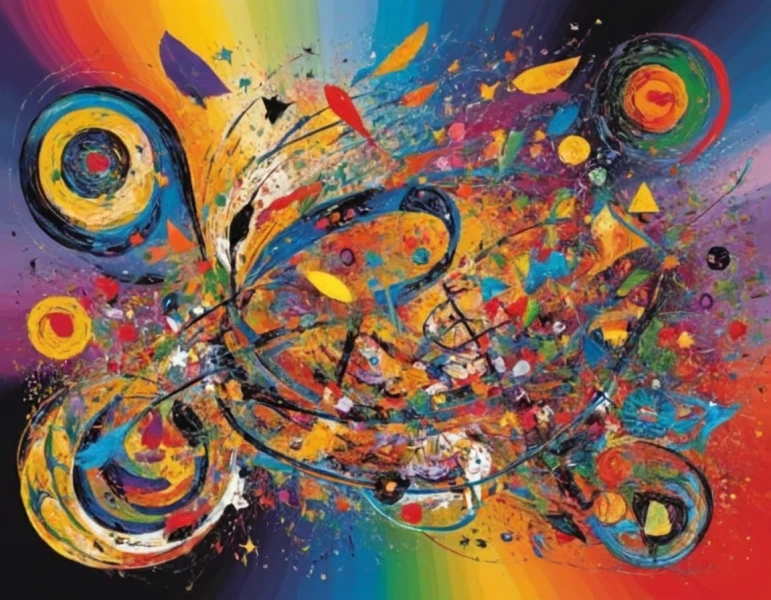Educa UNIVERSITY|ART AND ARCHITECTURE
Abstract art: a look from experience
Related Masters
Abstract art: a look from experience
To speak of abstract art is like entering a vast and free terrain, without ties to recognizable forms or restrictions to the rules of traditional representation. As someone who has had the good fortune to live with this form of expression throughout my life, I can tell you that abstract art is more than colors and scattered forms; it is a way to communicate emotions, ideas and even philosophies of life without having to rely on the figurative. It is pure freedom on the canvas!
The birth of abstract art

Abstract art as an artistic movement emerged in the early 20th century, with artists like Wassily Kandinsky and Piet Mondrian breaking the molds of figurative representation. The goal? To represent something deeper than the simple image of what we see in the outside world. Kandinsky, for example, focused on colors and shapes that, rather than imitating real objects, evoked sensations. That's how powerful this style is! As he said, "the color is the keyboard, the eyes are the hammers, the soul is the piano with many strings."
Features of abstract art
The fascinating thing about abstract art is that it is stripped of the need to be understood by its appearance. It is about transmitting, not representing. While figurative art relies on recognizable forms and elements, abstraction focuses on pure elements: lines, colors, geometric figures, and the arrangement of space. Thus, each work comes to life differently depending on the eye that observes it. And the best part? You don't need to have academic knowledge to appreciate it.
If you are in front of a work by Jackson Pollock, like those of abstract expressionism, you will probably feel enveloped in a dance of colors that seem to be in full motion. His dripping technique catapulted him as an icon of this style, creating canvases full of energy. Meanwhile, Piet Mondrian opted for geometric abstraction, where squares and straight lines took center stage, symbolizing an almost spiritual balance.
Compositional and conceptual freedom
Here's the key! Abstract art allows artists to ditch traditional rules and create with no strings attached. Shapes, colors, and ideas float on a canvas that invites imagination and introspection. It is a window open to total experimentation. From lyrical movements, where emotions and feelings predominate, to geometric abstraction, which explores the logic and structure of forms, each strand of abstract art offers something different.
Types of abstract art
Within abstract art, there are several currents worth mentioning:
Abstract Expressionism: It emerges in the 1940s in New York and is characterized by its explosive energy, like the works of Jackson Pollock. Here, art is a direct channel to express emotions without recognizable forms, using techniques that might seem chaotic but are deeply intentional.
Geometric abstraction: This strand, where Mondrian stands out, uses basic geometric forms to create balance and harmony. It is a more "rational" art, but no less exciting for that. The interplay between primary colors and straight lines offers a fascinating symmetry.
Lyrical abstraction: Here, the art becomes more poetic. The colors, the brushstrokes, the shapes, everything seems to flow like a visual symphony. Artists like Wassily Kandinsky stand out for the way their works seem to take you into a parallel universe, full of sensations and emotional movements.
The relevance of abstract art today
Although the rise of abstract art as a movement took place in the 20th century, it is still relevant today. And it's not hard to understand why. We live in a society saturated with literal images and representations, and abstract art offers us a respite, a space for introspection and emotional connection.
You don't need to understand "what is" an abstract work; you just feel it. And this, to me, is the most powerful thing about abstract art. If you are confronted with an abstract work and it leaves you with a feeling, an idea, an emotion, it has already served its purpose!
My personal experience with abstract art
As someone who has had the opportunity to explore abstract art in various facets of my life, I can tell you that this artistic style has taught me to see beyond the obvious. Sometimes, life itself is an abstraction, full of elements that don't always have a clear form, but always communicate something.
I remember the first time I planted myself in front of a Mondrian. "What's so special about it?", I wondered. But as I became immersed in the simplicity of the lines and colors, I began to understand that abstract art is not about what you see, but about what it makes you feel.
And no, I'm not going to tell you it's easy to understand or "like" from the get-go. But once you connect with that freedom, it's as if abstract art becomes an extension of your own mind.
Conclusion
Abstract art is an invitation to see the world differently. To understand that beauty is not always in the figurative, in what we can describe with words or identify easily. It is, in its essence, a pure expression of the internal, a way of communicating what cannot always be said. As I expressed it before, every time you face an abstract work, you are seeing a reflection of the soul of its creator, but also of your own.
Faculties
Trainings
The faculties embrace diverse academic disciplines and fields of study, opening doors to new perspectives and exploring different spheres of wisdom in a constantly evolving world.
Legal Notice • Enrollment Conditions • Privacy Policy • Cookie Policy• Copyright @ 2024 • Educa University
Powered by














